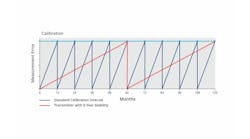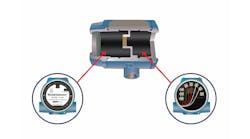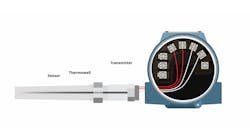Every month, Control's editors take a specific product area, collect all the latest, significant tools we can find, and present them here to make your job easier. If you know of any tools and resources we didn’t include, send them to [email protected], and we’ll add them to the website.
PRECISION TEMPERATURE MEASUREMENT
For exacting needs in industrial uses, the temperature of a process must be measured and controlled definitively. Even changes of a fraction of a degree Celsius can be wasteful or even catastrophic in many situations. New equipment and standards, such as LAN Extensions for Instrumentation (LXI) offer a methodology to perform these exacting measurements in test and control applications. What do you need to know to select the best temperature measurement solution for your test and control application? This white paper, "Avoid Pitfalls in Precision Temperature Measurement," describes the common problems of precision temperature measurement and what you need to consider before selecting a temperature measurement solution. The direct URL is at http://tinyurl.com/4cmzxmz.
Data Translation
800/525-8528
www.datatranslation.com
TEMPERATURE CALIBRATION
The white paper, "Calculating Total Uncertainty of Temperature Calibration with a Dry Block," discusses the various uncertainty components related to temperature calibration using a temperature dry block, and how to calculate the total uncertainty of a calibration performed with a dry block. It is possible to use a dry block with the block’s internal measurement as the reference (true value), or you can also use an external reference temperature probe inserted in the block as a reference measurement. Read the entire white paper at http://tinyurl.com/86s6jzv. The paper is free, but registration is required.
Beamex
www.beamex.com
WIRELESS TEMPERATURE MONITORING
The growth of wireless instrumentation technology has provided new ways to apply temperature measurement sensors combined with personal computers to collect, tabulate and analyze the data obtained. "Wireless Devices Deliver Great Benefits for Temperature Monitoring" discusses the various kinds of basic wireless transmitters and receivers and their use cases. As a bonus, most of the devices discussed also work with humidity and barometric pressure sensors. Read the white paper at http://tinyurl.com/844qsew. The download is free.
Omega Engineering
888/826-6342
www.omega.com
ALL ABOUT TEMPERATURE
This website is a conglomeration of both vendor and educational information about temperature sensor technology. It contains multiple links to videos, lectures, white papers, demonstrations and other sources of information on subjects ranging from temperature-related standards to types of temperature-sensing tools to specification and calibration. There are both introductory and advanced takes on multiple temperature topics.
Temperatures.com
www.temperatures.com/sensors
FIBER-OPTIC TEMPERATURE SENSING
Fiber-optic distributed temperature sensing (FO-DTS) is an emerging technology that has promise for characterizing estuary-aquifer and stream-aquifer interaction, and for identifying transmissive fractures in bedrock boreholes. The "Fiber-Optic Distributed Temperature Sensing Technology Demonstration and Evaluation Project" of the U.S. Geological Survey website contains information about this technology, which has uses for measuring temperature and strain in petroleum wells. The site contains links to various demonstration and evaluation projects for use of the technology in river and estuary environments, as well as links to other videos, lectures and papers on the subject. The direct link is at http://water.usgs.gov/ogw/bgas/fiber-optics/.
U.S. Geological Survey
www.usgs.gov
RFID TEMPERATURE SENSING
RFID Sensors wirelessly transmit temperature data from a sensor that has no battery. The sensor uses the RF energy from the RFID reader to power the electronics and transmit the reading. Not having a battery makes these sensors ideal in many applications, such as food safety. This video demonstrates the reading of a tag with multiple handheld readers. It also shows the performance of the tag at low freezing temperatures and against metal. The video highlights several of the recent advancements in RFID sensor performance and packaging, including an RFID temperature food probe. The direct link is at www.youtube.com/watch?v=EuBb1XnLyHY.
Phase IV Engineering
866/608-6168
www.phaseivengr.com



